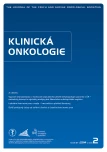-
Medical journals
- Career
Continuing Progress in Withdrawal of Axillary Dissection in Early Stage Breast Cancer
Authors: D. Vrána 1,2; J. Gatěk 3,4; K. Cwiertka 1; V. Šrámek 1
Authors‘ workplace: Onkologická klinika LF UP a FN Olomouc2 Oddělení toxikogenomiky, Centrum toxikologie a zdravotní bezpečnosti, Státní zdravotní ústav, Praha 3 Chirurgické oddělení, Nemocnice Atlas, Zlín4 Fakulta humanitních studií, Univerzita T. Bati ve Zlíně 1
Published in: Klin Onkol 2014; 27(2): 143-145
Category: Short Communication
Overview
For a long period of time, axillary dissection represented a standard approach for axillary node management in the case of sentinel node biopsy positivity during early stage breast cancer treatment. In recent years, there has been a trend to highlight the morbidity of such an axillary procedure considering long‑term survival of early stage breast cancer patients. Two big trials, AMAROS and Z0011, were initiated to answer the question whether axillary dissection should be performed in the case of positivity of axillary sentinel node considering the fact that more than 70% of these patients will have no metastasis found during the axillary dissection and such a procedure only increases the morbidity of the surgery. Considering the results of the above mentioned trials, axillary dissection may be avoided in the case of fulfilling of inclusion criteria of these trials without any impact on the patient survival. IBCSG 23 – 01 study brought similar conclusion in the case of micrometastasis in axillary sentinel node.
Key words:
axillary dissection – breast cancer – radiotherapy – breast-conserving surgery
Sources
1. Veronesi U, Paganelli G, Galimberti V et al. Sentinel ‑ node biopsy to avoid axillary dissection in breast cancer with clinically negative lymph ‑ nodes. Lancet 1997; 349(9069): 1864 – 1867.
2. Giuliano AE, Hunt KK, Ballman KV et al. Axillary dissection vs. no axillary dissection in women with invasive breast cancer and sentinel node metastasis. JAMA 2011; 305(6): 569 – 575. doi: 10.1001/ jama.2011.90.
3. Sabel SM. Re ‑ evaluating the use of ALND in the context of Z0011. Breast Cancer Symposium 2013.
4. Harbeck N, Thomssen C, Gnant M. St. Gallen 2013: brief preliminary summary of the consensus discussion. Breast Care (Basel) 2013; 8(2): 102 – 109. doi: 10.1159/ 000351193.
5. Eortc.org [homepage on the Internet]. EORTC – The future of cancer therapy. Available from: / / www.eortc.org/ news/ eortc ‑ study ‑ shows ‑ radiotherapy ‑ and ‑ surgery ‑ provide ‑ excellent ‑ regional ‑ control ‑ breast ‑ cancer ‑ pat.
6. Galimberti V, Cole BF, Zurrida S et al. Axillary dissection versus no axillary dissection in patients with sentinel ‑ node micrometastases (IBCSG 23 – 01): a phase 3 randomised controlled trial. Lancet Oncol 2013; 14(4): 297 – 305. doi: 10.1016/ S1470 - 2045(13)70035 - 4.
Labels
Paediatric clinical oncology Surgery Clinical oncology
Article was published inClinical Oncology

2014 Issue 2-
All articles in this issue
- Zajímavé případy z nutriční péče v onkologii
- The Role of MicroRNAs in Molecular Pathology of Esophageal Cancer and Their Potential Usage in Clinical Oncology
- Lobular Breast Cancer in Man – Case Report and Review of the Literature
- Psychoneuroimmunology in Context of Comprehensive Breast Cancer Treatment
- Anakinra Treatment in Schnitzler Syndrome – Results of the First Retrospective Multi‑center Study in Six Patients from the Czech Republic
- On the Importance of Standardization in the Assessment of Population‑based Cancer Patient Survival in the Czech Republic – Methodology and Results from the Czech National Cancer Registry
- Continuing Progress in Withdrawal of Axillary Dissection in Early Stage Breast Cancer
- Wage‑ specific Assessment of Mammography Screening in Brazilian Women
- Adenocarcinoma of the Rete Testis – a Rare Case of Testicular Malignancy
- Renal Oncocytoma with Invasive Histopathologic Features – Case Report
- Massive Cutaneous Metastasis of a Renal Cell Carcinoma
- Clinical Oncology
- Journal archive
- Current issue
- Online only
- About the journal
Most read in this issue- Psychoneuroimmunology in Context of Comprehensive Breast Cancer Treatment
- Renal Oncocytoma with Invasive Histopathologic Features – Case Report
- Continuing Progress in Withdrawal of Axillary Dissection in Early Stage Breast Cancer
- Lobular Breast Cancer in Man – Case Report and Review of the Literature
Login#ADS_BOTTOM_SCRIPTS#Forgotten passwordEnter the email address that you registered with. We will send you instructions on how to set a new password.
- Career
